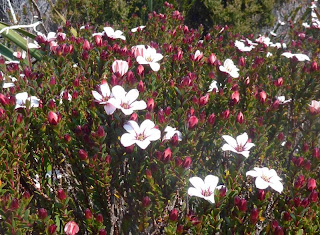Blog Entry #26: South Africa Day 5: Table Mountain
After efforts to visit a former Montana student of mine working in the Khayelitsha township fell through, Pat and I decided to take advantage of another beautiful sunny spring day to climb the local icon, Table Mountain.
We took a taxi to the base of the cable car, and then walked a km or so east to the Platteklip trail, the traditional and original route up Table Mountain, first climbed by Europeans in 1503 when the Portuguese navigator António de Saldanha landed in Table Bay and named the mountain Taboa do Cabo (Table of the Cape). The trail follows a large split in the rocks that follows all the way to the top, passing through what from below looks like an impassible layer of the Table Mountain sandstone cap.
 |
| Add caption |
Along the way we passed through the endangered Peninsula Sandstone Fynbos, with many flowers in bloom – some we had seen previously at Volmoed, but also several new varieties.
I was delighted to have a chance to hike the entire geologic column of the area, from the Cambrian or Precambrian Cape Granite at the base that intrudes the softer Malmsbury shale above (roughly 500 million years old).
 |
| Sign at top of Table Mountain explaining the geology |
Above this and forming the impressive cliffs all around Table Mountain is the Table Mountain Sandstone, of Ordovician age (roughly 450 million years) – beautiful, clean and white slightly metamorphosed quartz sandstone. Prominent crossbedding is still evident, as are several pebble-strewn conglomerate layers with quartz pebbles.
 |
| This sign shows the amount of erosion that has occurred in the past 260 million years to expose Table Mountain today |
Table Mountain apparently is the remnant of a major mountain-building period about 240 million years ago, as the Atlantic Ocean closed and Africa collided with the South American and Antarctic Continents. This diagram from the top of the mountain gives a nice explanation of the history – what we experience as the top of the mountain 200 million years ago was the buried roots!
 |
| View East from Table Mountain Summit over the University of Capetown (foreground) and the black townships in the distance |
 |
| Devil's Peak from Plattklip Gorge |
 |
| Capetown & Table Bay from summit of Table Mountain with Robben Island in distance |
 |
| Wetlands on top of Table Mountain |
| Visitors to Maclear's Beacon |
Equally moving were the groups of Black Africans who now ride the cable car and walk across the top of Table Mountain – often in their church clothes and dress shoes, shouting Alleluia! as they go. By 4 pm it was time for us to descend, and we decided to take the Cable Car, which rotates as you descend. First built in 1929, it takes only a few minutes to go down, giving thrilling views across Capetown and the Bay.
 |
| Twelve Apostles ridge with yellow fynbos |
We had to scramble to get back to the ship for a quick supper, as we had tickets to a one-man show at the Baxter Theatre in Rondebosch that we had to get to by 8 pm. We were going to see “Desperate First Ladies,” a hilarious political satire by gay activist and performer Pieter-Dirk Uys (http://www.pdu.co.za/). On the ship with us is Michael Williams, the Managing Director of the Capetown Opera (www.capetownopera.co.za/) and creator of a magnificent opera trilogy about Nelson Mandela, the Mandela Trilogy. Michael had recommended we see “Desperate First Ladies” as it was both a brilliant performance and astute political commentary and satire on South Africa, past and present. Pieter-Dirk Uys regularly got in trouble with the authorities during the apartheid era for satirizing the authorities, and he continues that tradition today into his seventies – though now without the worry of arrest and detention.











What amazing views from the mountaintop! (in more ways than one...)
ReplyDelete